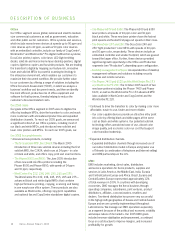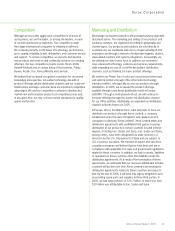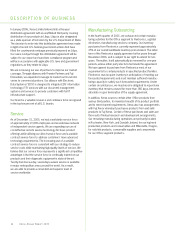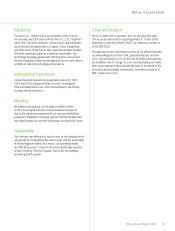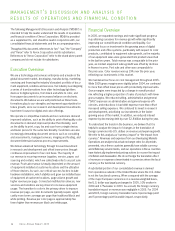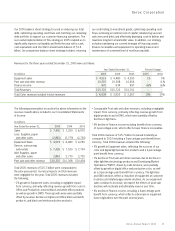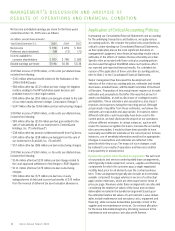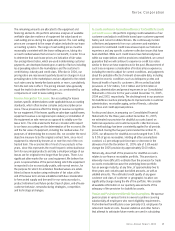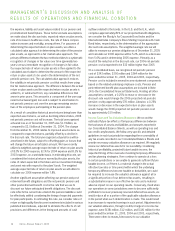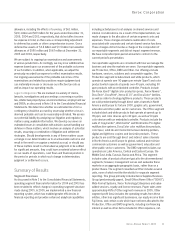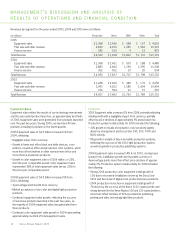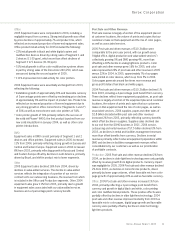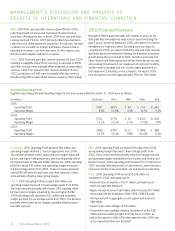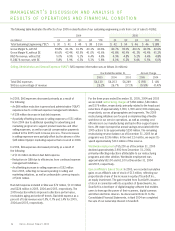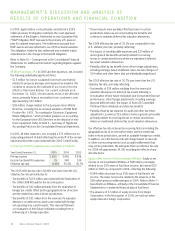Xerox 2005 Annual Report Download - page 36
Download and view the complete annual report
Please find page 36 of the 2005 Xerox annual report below. You can navigate through the pages in the report by either clicking on the pages listed below, or by using the keyword search tool below to find specific information within the annual report.
MANAGEMENT’S DISCUSSION AND ANALYSIS OF
RESULTS OF OPERATIONS AND FINANCIAL CONDITION
28
Net income and diluted earnings per share for the three years
ended December 31, 2005 were as follows:
(in millions, except share amounts)
Year Ended December 31, 2005 2004 2003
Net income $ 978 $ 859 $ 360
Preferred stock dividends (58) (73) (71)
Income available to
common shareholders $ 920 $ 786 $ 289
Diluted earnings per share $0.94 $0.86 $0.36
2005 Net income of $978 million, or 94 cents per diluted share,
included the following:
•$343 million after-tax benefit related to the finalization of the
1996-1998 IRS audit.
•$84 million after-tax ($115 million pre-tax) charge for litigation
matters relating to the MPI arbitration panel decision and
probable losses for other legal matters.
•$58 million after-tax ($93 million pre-tax) gain related to the sale
of our entireequity interest in Integic Corporation (“Integic”).
•$247 million after-tax ($366 million pre-tax) restructuring charges.
2004 Net income of $859 million, or 86 cents per diluted share,
included the following:
•$83 million after-tax ($109 million pre-tax) gain related to the
sale of substantially all of our investment in ContentGuard
Holdings, Inc. (“ContentGuard”).
•$38 million after-tax pension settlement benefit from Fuji Xerox.
•$30 million after-tax ($38 million pre-tax) gain from the sale of
our investment in ScanSoft, Inc. (“ScanSoft”).
•$57 million after-tax ($86 million pre-tax) restructuring charges.
2003 Net income of $360 million, or 36 cents per diluted share,
included the following:
•$146 million after-tax ($239 million pre-tax) charge related to
the court-approved settlement of the Berger v. RIGP litigation.
•$111 million after-tax ($176 million pre-tax) restructuring
charges.
•$45 million after-tax ($73 million pre-tax) loss on early
extinguishment of debt and income tax benefits of $35 million
from the reversal of deferred tax asset valuation allowances.
Application of Critical Accounting Policies
In preparing our Consolidated Financial Statements and accounting
for the underlying transactions and balances, we apply various
accounting policies. We consider the policies discussed below as
critical to understanding our Consolidated Financial Statements,
as their application places the most significant demands on
management’s judgment, since financial reporting results rely on
estimates of the effects of matters that are inherently uncertain.
Specific risks associated with these critical accounting policies
are discussed throughout this MD&A where such policies affect
our reported and expected financial results. For a detailed dis-
cussion of the application of these and other accounting policies,
refer to Note 1 to the Consolidated Financial Statements.
Senior management has discussed the development and
selection of the critical accounting policies, estimates and related
disclosures, included herein, with the Audit Committee of the Board
of Directors. Preparation of this annual report requires us to make
estimates and assumptions that affect the reported amount of
assets and liabilities, as well as disclosureof contingent assets
and liabilities. These estimates and assumptions also impact
revenues and expenses during the reporting period. Although
actual results may differ from those estimates, we believe the
estimates are reasonable and appropriate. In instances where
different estimates could reasonably have been used in the
current period, we have disclosed the impact on our operations
of these different estimates. In certain instances, such as with
respect to revenue recognition for leases, because the accounting
rules areprescriptive, it would not have been possible to have
reasonably used different estimates in the current period. In these
instances, use of sensitivity information would not be appropriate.
Changes in assumptions and estimates are reflected in the
period in which they occur.The impact of such changes could
be material to our results of operations and financial condition
in any quarterly or annual period.
Revenue Recognition Under Bundled Arrangements: We sell most
of our products and services under bundled lease arrangements,
which typically include equipment, service, supplies and financing
components for which the customer pays a single negotiated
monthly fixed price for all elements over the contractual lease
term. These arrangements typically also include an incremental,
variable component for page volumes in excess of contractual
page volume minimums, which are often expressed in terms of
price per page. Revenues under these arrangements are allocated
considering the relative fair values of the lease and non-lease
deliverables included in the bundled arrangement based upon
the estimated relative fair values of each element. Lease deliver-
ables include maintenance and executory costs, equipment and
financing, while non-lease deliverables generally consist of the
supplies and non-maintenance services. Our revenue allocation
for the lease deliverables begins by allocating revenues to the
maintenance and executory costs plus profit thereon.
Xerox Annual Report 2005




